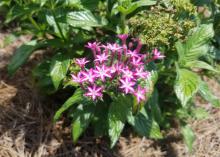Information Possibly Outdated
The information presented on this page was originally released on August 15, 2022. It may not be outdated, but please search our site for more current information. If you plan to quote or reference this information in a publication, please check with the Extension specialist or author before proceeding.
Summer pentas also can thrive in the fall
As the time nears for summer to turn to fall and temperatures drop, I get excited thinking about the changes this will bring to the landscape. Depending on where you garden in Mississippi, September, October and November can be filled with some of the brightest colors of the year.
I like to watch warm-season, flowering annuals that have been struggling a bit from a long, hot summer season get what I call their second wind and start to produce really pretty flowers again. Pentas are a good examples. While they have good tolerance for our summer heat and humidity, they are absolutely among the best fall color annuals.
These plants are known not only for the pretty flower colors, but also for being pollinator magnets.
In the fall, as the weather is changing, an environmental signal tells the pollinators that it’s time to get ready for winter. I love seeing all the different species of butterflies and bumblebees vying for position on the broad penta flowerheads. You can even see hummingbirds harvesting nectar while they get ready to migrate south.
As a testament to their tough landscape and garden performance, the Butterfly penta series was chosen as a Mississippi Medallion winner in 2001. Since that time, there have been many more series introduced to the market. Lucky Star, Glitterati, Graffiti, Honey Cluster and New Look are just a few.
Colors within these series are similar, including white, lavender, rose, pink and red. In my opinion, it doesn’t matter which series you plant, because they all look good.
The name penta comes from the Latin word for “five,” since each small flower has five petals. The other name commonly used for these plants is Egyptian Starflowers. Each penta plant frequently has up to 20 clusters of flowers at any given time.
Pentas need to be planted in an area that gets full sun, typically at least 6 hours a day. They can be planted in raised landscape beds, and I think they look great massed in a big container on the porch or patio. Either way, good drainage is important, as pentas don’t like wet feet.
Pentas also like a consistent level of fertilization.
I use a controlled-release product at planting and then a water-soluble fertilizer every two to three weeks through the flowering season to keep the blooms coming. Be sure to deadhead the spent flower clusters, as this will promote more flowering through the season.
Pentas are usually planted in late spring or early summer, but this past week, I saw some at the local garden centers that were still looking good
I wouldn’t hesitate to plant some pentas this fall. Then sit back and watch the butterflies, bumblebees and hummingbirds that will be drawn to your garden and landscape.


